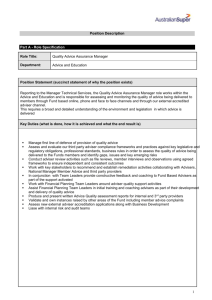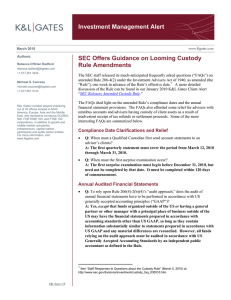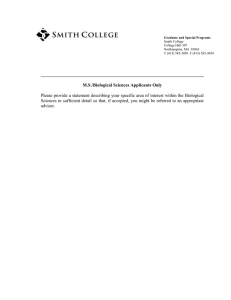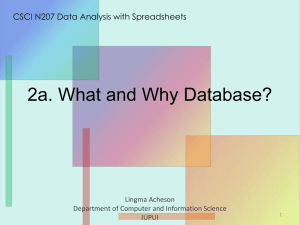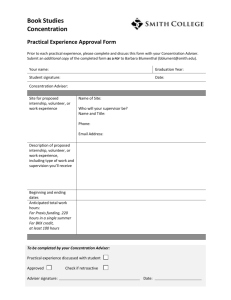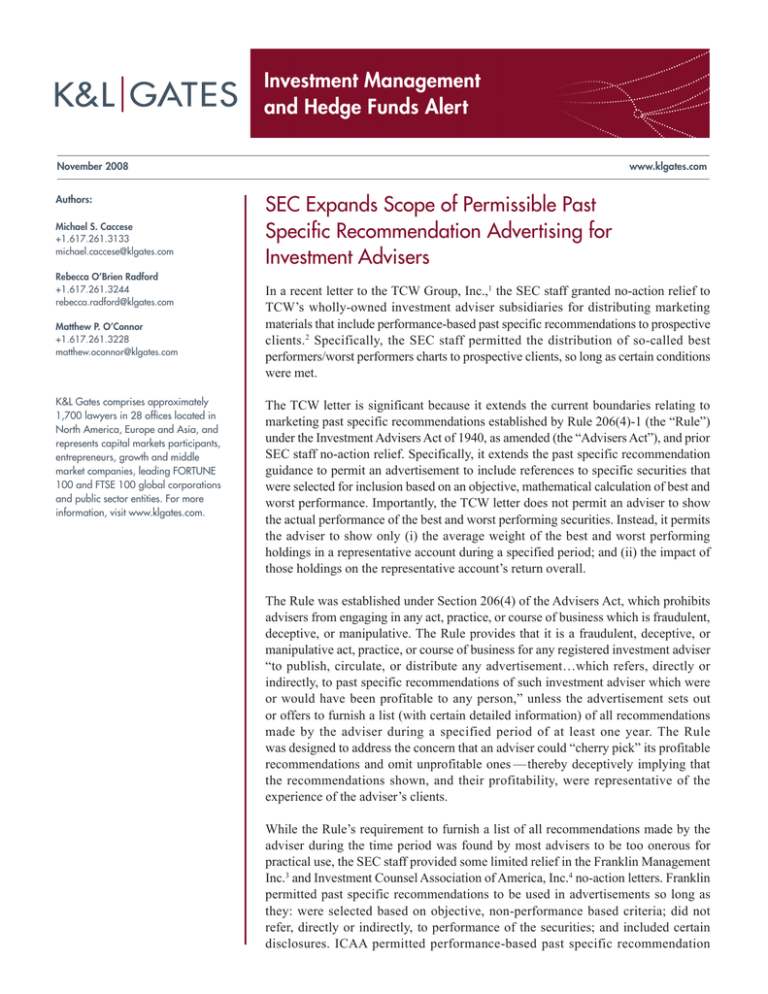
Investment Management
and Hedge Funds Alert
November 2008
Authors:
Michael S. Caccese
+1.617.261.3133
michael.caccese@klgates.com
Rebecca O’Brien Radford
+1.617.261.3244
rebecca.radford@klgates.com
Matthew P. O’Connor
+1.617.261.3228
matthew.oconnor@klgates.com
K&L Gates comprises approximately
1,700 lawyers in 28 offices located in
North America, Europe and Asia, and
represents capital markets participants,
entrepreneurs, growth and middle
market companies, leading FORTUNE
100 and FTSE 100 global corporations
and public sector entities. For more
information, visit www.klgates.com.
www.klgates.com
SEC Expands Scope of Permissible Past
Specific Recommendation Advertising for
Investment Advisers
In a recent letter to the TCW Group, Inc.,1 the SEC staff granted no-action relief to
TCW’s wholly-owned investment adviser subsidiaries for distributing marketing
materials that include performance-based past specific recommendations to prospective
clients.2 Specifically, the SEC staff permitted the distribution of so-called best
performers/worst performers charts to prospective clients, so long as certain conditions
were met.
The TCW letter is significant because it extends the current boundaries relating to
marketing past specific recommendations established by Rule 206(4)-1 (the “Rule”)
under the Investment Advisers Act of 1940, as amended (the “Advisers Act”), and prior
SEC staff no-action relief. Specifically, it extends the past specific recommendation
guidance to permit an advertisement to include references to specific securities that
were selected for inclusion based on an objective, mathematical calculation of best and
worst performance. Importantly, the TCW letter does not permit an adviser to show
the actual performance of the best and worst performing securities. Instead, it permits
the adviser to show only (i) the average weight of the best and worst performing
holdings in a representative account during a specified period; and (ii) the impact of
those holdings on the representative account’s return overall.
The Rule was established under Section 206(4) of the Advisers Act, which prohibits
advisers from engaging in any act, practice, or course of business which is fraudulent,
deceptive, or manipulative. The Rule provides that it is a fraudulent, deceptive, or
manipulative act, practice, or course of business for any registered investment adviser
“to publish, circulate, or distribute any advertisement…which refers, directly or
indirectly, to past specific recommendations of such investment adviser which were
or would have been profitable to any person,” unless the advertisement sets out
or offers to furnish a list (with certain detailed information) of all recommendations
made by the adviser during a specified period of at least one year. The Rule
was designed to address the concern that an adviser could “cherry pick” its profitable
recommendations and omit unprofitable ones —thereby deceptively implying that
the recommendations shown, and their profitability, were representative of the
experience of the adviser’s clients.
While the Rule’s requirement to furnish a list of all recommendations made by the
adviser during the time period was found by most advisers to be too onerous for
practical use, the SEC staff provided some limited relief in the Franklin Management
Inc.3 and Investment Counsel Association of America, Inc.4 no-action letters. Franklin
permitted past specific recommendations to be used in advertisements so long as
they: were selected based on objective, non-performance based criteria; did not
refer, directly or indirectly, to performance of the securities; and included certain
disclosures. ICAA permitted performance-based past specific recommendation
Investment Management and Hedge Funds Alert
information to be presented to a prospective client
if the prospective client made an unsolicited
request for the information. However, the adviser
was constrained by Franklin in that it could not
use performance in selecting which securities
to highlight; and by ICAA in only providing the
information if it was specifically requested by
the prospective client. The TCW letter relaxes
these limitations, but continues the prohibition
against referencing the actual performance of a
specific holding.
With the publication of the TCW letter, registered
investment advisers may now show certain
information about past specific recommendations
that were selected based on objective, mathematical
performance-based criteria, so long as the following
rules are observed:
• the best and worst holdings are selected by
taking into account consistently the weighting
of every holding in a representative account that
contributed to the account’s performance during
a period of time (the “Measurement Period”);
• the Measurement Period consists of at least a
full calendar month, as computed as of the most
recent calendar month’s last trading day;
• the presentation of information and number of
holdings is consistent from period to period;
• the presentation shows no fewer than a total of
ten holdings, including an equal number of the
best and worst performing holdings during the
Measurement Period;
• the presentation includes all information necessary
to make the information not misleading, including
showing the best and worst performing holdings
on the same page with equal prominence;
• t he presentation includes the following
disclosures in close proximity to (i.e., on the
same page as) the performance information: (i)
how to obtain the calculation methodology; (ii)
how to obtain a list showing the contribution
of each holding in the representative account
to the overall account’s performance during
the Measurement Period; (iii) that the holdings
identified do not represent all of the securities
purchased, sold or recommended for the
adviser’s clients; and (iv) that past performance
does not guarantee future results; and
• the adviser maintains, and makes available to the
SEC staff upon request, records that evidence:
(i) the criteria used to select the specific holdings
listed; (ii) a list showing the contribution of
each holding in the representative account to
the overall account’s performance during the
Measurement Period; and (iii) all supporting
data necessary to demonstrate the calculation of
the contribution analysis and the appropriateness
of the holdings included in each presentation.
1
ee http://www.sec.gov/divisions/investment/noaction/2008/
S
tcwgroup110708.htm.
2
“ Prospective clients” means those potential clients with
no current ties to the advisory firm, as well as consultants
and clients of the advisory firm currently invested in
unrelated strategies.
3
ee Franklin Management, Inc., SEC Staff No-Action Letter
S
(Dec. 10, 1998) (“Franklin”).
4
ee Investment Counsel Association of America, Inc.,
S
SEC Staff No-Action Letter (March 1, 2004).
K&L Gates comprises approximately 1,700 lawyers in 28 offices located in North America, Europe and Asia, and represents capital markets
participants, entrepreneurs, growth and middle market companies, leading FORTUNE 100 and FTSE 100 global corporations and public sector
entities. For more information, visit www.klgates.com.
K&L Gates comprises multiple affiliated partnerships: a limited liability partnership with the full name K&L Gates LLP qualified in Delaware and
maintaining offices throughout the U.S., in Berlin, in Beijing (K&L Gates LLP Beijing Representative Office), and in Shanghai (K&L Gates LLP Shanghai
Representative Office); a limited liability partnership (also named K&L Gates LLP) incorporated in England and maintaining our London and Paris
offices; a Taiwan general partnership (K&L Gates) which practices from our Taipei office; and a Hong Kong general partnership (K&L Gates,
Solicitors) which practices from our Hong Kong office. K&L Gates maintains appropriate registrations in the jurisdictions in which its offices are
located. A list of the partners in each entity is available for inspection at any K&L Gates office.
This publication is for informational purposes and does not contain or convey legal advice. The information herein should not be used or relied upon
in regard to any particular facts or circumstances without first consulting a lawyer.
©1996-2008 K&L Gates LLP. All Rights Reserved.




